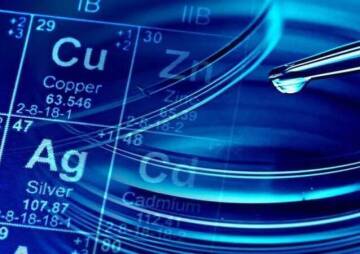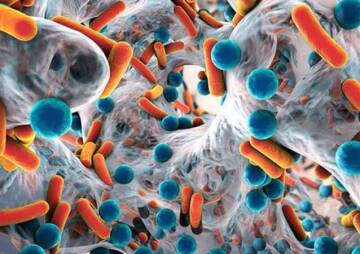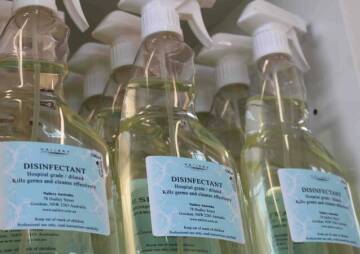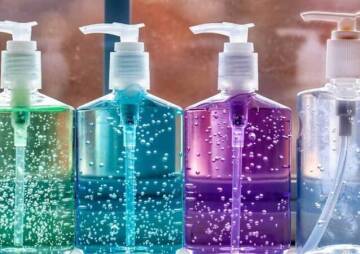-
Category
Craniomaxillofacial Surgery
Orthopedic Surgery
Spine Surgery
Orthopedic Implants
Hip Surgery
Knee Surgery
Pectus Excavatum
Bone Graft
Disinfectants
Healthcare
Silver Nanoparticles, Small Particles with Wide Performance

Silver nanoparticles are one of the most essential and attractive metal nanoparticles. Today's, AgNPs are utilized in several fields such as medical, food, health, and industrial sciences due to their unique chemical and physical properties.
In recent years, many advances in nanotechnology and nanoscience have been developed. They have mainly created many changes, especially in the prevention, diagnosis, and treatment of diseases. Silver nanoparticles (AgNPs) are one of the most essential and attractive metal nanoparticles. Today's, AgNPs are increasingly utilized in several fields such as medical, food, health, and industrial sciences due to their unique chemical and physical properties. Knowledge of this nanoparticle has contributed a lot to various sciences. This research describes the silver nanoparticles and how they work.
The importance of silver
The shiny white precious metal silver is also a natural antibiotic that kills bacteria. This advantage has been recognized since time immemorial. In the past, wealthy Romans ate with knives, forks, and silver spoons. They understood that silver prevents them from getting sick. Of course, eating silverware today is more about showing off one's wealth than about health.
Nevertheless, silver still has its place in medicine. In the last decade, the use of silver as a germ killer has expanded dramatically, in which this increase in use has not been restricted to medicine. Since about 2005, many companies began adding a particular silver form to a wide range of their products, which were amazingly small particles, so-called silver nanoparticles. Today's nanoparticles are utilized in toothbrushes, socks, washing machines, vacuum cleaners, and other items. However, how did these tiny particles become so important?
Silver nanoparticles, small particles with a large surface area
Nanotechnology is growing advancing. This technology emphasizes nanoparticles' impact via a size of billions of meters and the products generated by them. In this matter, silver nanoparticles are one of the most effective nanoparticles. However, why? For many years, silver has also been utilized in medical treatments due to its natural antifungal and antibacterial properties. Silver nanoparticles are usually 25 nanometers in size, which are so tiny that they can penetrate small spaces.
On the other hand, although these silver nanoparticles are tiny, their surface area is very high, which means they have a relatively large surface area relative to their volume. As such, the higher the level means the more significant the chemical reactions. Therefore, its ability to be exposed to fungi and bacteria is increased so that its antimicrobial performance can be enhanced.

Moreover, due to their ability to kill high-strength pathogens at low concentrations, silver nanoparticles (AgNP) have become popular. In contact with bacteria and fungi, these nanoparticles negatively affect their cellular metabolism and inhibit their cell growth. As a result, they prevent bacteria and fungi' growth that cause infection, itching, and ulceration [1]. The nanosilver's ability to prevent the spread of infection is due to the release of silver ions (Ag+) from the surface of this material, which can remove phosphorus and sulfur compounds in fungi, bacteria, or viruses. Here, it is worthwhile to mention that silver nanoparticles have fast and efficient performance. They are anti-allergic, non-toxic, non-irritating, stable in water, and do not oxidize in air. They have high resistance and are hydrophilic. Besides, AgNPs have become popular because of their optical, antimicrobial, electrical, and catalytic properties [2]. In addition to medical applications, all of these futures have led to silver nanoparticles can be employed in health products, household products, cosmetics, sanitary towels, lingerie, disinfectant sprays, electronic surface coatings, textiles, metals, wood, glass, ceramics, paper, plastic resin blends, fiber fibers, and so on.

How silver nanoparticles work in killing bacteria
Among various metal elements known as bactericidal, the silver nanoparticles are receiving more attention because of their strong bactericidal and inhibitory effects. In this regard, how they work can be interpreted in two ways. One potential route is that after interacting with bacteria, AgNPs induce the activated oxygen species and free radicals, resulting in damaging intracellular organs. Another mechanism is the ability of AgNPs to adhere to the bacterial wall, followed by the silver nanoparticles penetrating the bacterial cell membrane, resulting in the leakage of cell contents and then death [2]. For instance, Das et al. [2] investigated the antimicrobial activity of small AgNPs (12 nm). They showed that these NPs are excellent inhibitors against gram-negative and gram-positive bacteria, including Staphylococcus aureus, Staphylococcus aureus, and Pseudomonas aeruginosa [2]. Simultaneously, they are very effective against various viruses such as immune deficiency virus, hepatitis B virus, herpes simplex virus, para-virus [2].

What happens if nanosilver enters human cells?
To answer this question, Jim Hutchison, a chemist and nanoparticle specialist at the University of Oregon, is one of the scientists trying. Hutchison says the most famous side effect of silver is a so-called disease Argiria. Usually, people may get the disease that is exposed to large amounts of silver. It should be noted that Argiria causes the skin to turn blue-gray. However, it does not seem to affect other aspects of a person's health. People sometimes suffered from Argiria, so-called blue blood, when many nobles used silver utensils for food. Note that blue blood contains much colloidal silver, a liquid in which silver particles are suspended.

Meanwhile, In addition to argiria, the colloidal silver may interfere with the absorption of thyroid-deficient and antibiotics drugs [3]. Overall, Hutchison's research revealed that the silver nanoparticles and silver ions are not harmful to humans. Of course, he emphasized that there was never any proof that its technology was completely safe. On the other hand, it is not possible to prove that it may be toxic. Nevertheless, Hutchison mentioned that any possible side effects could be taken into account by consuming high doses of silver in several products.
Silver nanoparticles in the food industry
In the food industry, silver nanoparticles are exploited for packaging and storage to increase food quality and shelf life. In this matter, many conducted studies indicated that AgNPs included in the food packaging might penetrate food and then be used. Although silver around 20-80 micrograms will not create a problem, they affect the mucosal layer significantly and are transferred to the bloodstream and reach each organ [2].
The effect of silver nanoparticles on the skin
The skin, a kind of defense wall of the body, is one of the most extensive parts of the body that contains a high potential to absorb silver nanoparticles. These nanoparticles penetrate healthy or cracked skin and then spread through the blood to various parts of the body. It should be mentioned that the silver nanoparticles are exposed to the skin through cosmetics, hand sanitizers, medical dressings, and nano-fabrics [2].

The effect of silver nanoparticles on the environment
Although small amounts of silver nanoparticles do not harm the environment, there is talk of long-term use of high volumes of these nanoparticles. Silver nanoparticles, known as highly reactive oxygen species, can generate unique chemicals more than larger silver forms. These chemicals materials may inhibit the growth of beneficial bacteria [4]. For instance, washing machines coated with silver nanoparticles transfer these particles to the sewage after washing and rinsing, which discharges the sewage into lakes and rivers in most cases. "As these nanoparticles are so small, they can flow in water over long distances that can be absorbed by fish," says Maynard. At the same time, they may settle as sediments at the bottom of rivers and lakes, which would result in damaging many beneficial microscopic organisms in those areas. In the meantime, these microscopic organisms often play a critical role in the life cycle of marine organisms, decomposing dead animals, and plant debris. After decomposing nitrogen, phosphorus, and carbon, the dead organisms are recycled and used by other aquatic organisms. Now, if these microorganisms are killed by silver nanoparticles and fail to do their works, marine organisms' food will be decreased. Therefore several irreparable damages would result in the environment. Note that the treated wastewater as fertilizer is also a common practice. If there are large amounts of silver nanoparticles in the water, the soil used to grow food may be damaged [4].
Do the silver nanoparticles cause poisoning in humans?
There are many expectations about the use of nanoparticles. Nonetheless, the toxicity of AgNPs on living organisms and the related health problems is worrying when their concentrations exceed a specific level. Nevertheless, when silver is present as a nanoparticle, toxicity is reduced because it is eliminated through urine and hair. However, the current knowledge about the toxicity of AgNPs to humans is based on the implemented laboratory and animal experiments; hence, there is no severe consensus on their toxicity. Therefore, the safety of AgNPs needs further investigation when utilizing in the human body, but currently, there are no reports about the toxic nanoparticles.

Silver nanoparticles as the last line of defense against viruses
Currently, the world is in a corona pandemic, in which there is no cure for this disease, and no approved vaccine has been discovered. Hence, the only way to prevent this disease is to avoid contact with this virus. In this way, many various strategies have been proposed, the most important of which are masks. However, what mostly causes the virus to spread is the contaminated surfaces and hand contact with these surfaces. Some simple steps can be performed to prevent it [5]. Note that viruses are not living things, and they are only structures in RNA and DNA that require the living cells to function. Accordingly, they are very vulnerable. Probably, AgNPs act on the surface of the virus and then physically inhibit contact with host cells [6]. In the structure of the virus, a sulfur atom reacts with silver that is destroyed. The silver nanoparticles and their unique structure can be spread on surfaces infected with the virus so that they kill these viruses. One of the conducted studies confirmed that antiseptic surface containing silver nanoparticles was 50% more effective to kill microbes than the conventional types [5].

The nanosilver antiseptic substances are a safe way to cope with Covid-19
Nanosilver disinfectant substances are a new class of non-alcoholic antiseptic substances, which are rapidly growing. These substances eliminate a wide range of microorganisms such as microbes, viruses, bacteria, fungi from surfaces and hands, without any need for washing. More importantly, they do not have the harmful effects of alcohol use. The conducted researches confirm that the nanosilver antiseptic can noticeably decrease the risk of health infections, based on which they kill about 99% of bacteria, microbes, and many viruses.

It is worthwhile to mention that the nanosilver antiseptic substances are created with materials that are usually foam-proof, non-irritating to the skin and eyes, and environmentally friendly. This is because they do not include the concentrated chemicals, enzymes, nitrates, phosphates, toxic hydrocarbon solvents, fatty acids, biodegradable surfactants, and ozone-depleting agents. Moreover, they can be utilized on hands and bodies, furniture, fabrics, clothing, air filters, carpets, walls, and floors. Regarding these interpretations, the choice of nanosilver antiseptics may be the best way to cope with coronavirus.
References:
- https://www.ncbi.nlm.nih.gov/pmc/articles/PMC5037809/
- https://www.nanosilver.com.my/nano-tech-facts/what-is-nano-silver/
- https://www.azonano.com/article.aspx?ArticleID=4446
- https://www.sciencenewsforstudents.org/article/nanosilver-naughty-or-nice
- https://www.ncbi.nlm.nih.gov/pmc/articles/PMC7177798/
- https://www.healthline.com/health/colloidal-silver#takeaway
- https://www.healthline.com/nutrition/colloidal-silver#should-you-use-it
- https://www.sciencedaily.com/releases/2008/04/080429135502.htm
- https://ras-ag.com/coronavirus/
- https://www.ncbi.nlm.nih.gov/pmc/articles/PMC6695748/
- https://product.statnano.com/product/11659/nano-silver-sanitizer
- https://www.lazada.com.my/products/nano-silver-multipurpose-sanitizer-nsms-hand-sanitiser-non-alcohol-50ml-ready-stocks-i933124275.html






